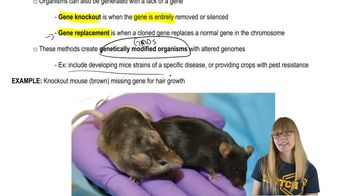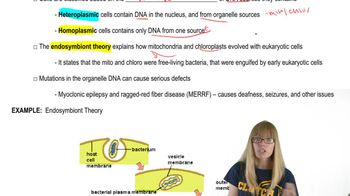Table of contents
- 1. Introduction to Genetics51m
- 2. Mendel's Laws of Inheritance3h 37m
- 3. Extensions to Mendelian Inheritance2h 41m
- 4. Genetic Mapping and Linkage2h 28m
- 5. Genetics of Bacteria and Viruses1h 21m
- 6. Chromosomal Variation1h 48m
- 7. DNA and Chromosome Structure56m
- 8. DNA Replication1h 10m
- 9. Mitosis and Meiosis1h 34m
- 10. Transcription1h 0m
- 11. Translation58m
- 12. Gene Regulation in Prokaryotes1h 19m
- 13. Gene Regulation in Eukaryotes44m
- 14. Genetic Control of Development44m
- 15. Genomes and Genomics1h 50m
- 16. Transposable Elements47m
- 17. Mutation, Repair, and Recombination1h 6m
- 18. Molecular Genetic Tools19m
- 19. Cancer Genetics29m
- 20. Quantitative Genetics1h 26m
- 21. Population Genetics50m
- 22. Evolutionary Genetics29m
3. Extensions to Mendelian Inheritance
Organelle DNA
Problem 27
Textbook Question
As described in this chapter, mothers will pass on a mitochondrial defect to their offspring. In a type of gene therapy, one approach to circumvent this problem is to have two different maternal contributions, with the nucleus of the female with the defective mitochondria being placed in an enucleated egg derived from a female with normal mitochondria. After fertilization, the resulting offspring would have three parental sources of DNA—with nuclear DNA derived from a mother and a father, and mitochondrial DNA derived from another 'mother.' Recently, children with this genetic makeup have been born, but the elimination of defective mitochondria is not complete, with the amount of defective mitochondria derived from the defective mother ranging from 0 to 9%. Discuss potential complications resulting from such a mixture of genomes.
 Verified step by step guidance
Verified step by step guidance1
Understand the concept of mitochondrial inheritance: Mitochondria are inherited maternally, meaning they are passed from mother to offspring through the egg cell. This is why mitochondrial defects are transmitted from mothers to their children.
Explore the gene therapy approach: In this scenario, the nucleus from a mother with defective mitochondria is transferred to an enucleated egg from a donor with healthy mitochondria. This creates an embryo with nuclear DNA from the biological parents and mitochondrial DNA from the donor.
Consider the implications of having three parental sources of DNA: The child will have nuclear DNA from both biological parents and mitochondrial DNA from the donor, which could lead to unique genetic interactions and potential complications.
Analyze the presence of defective mitochondria: Despite the therapy, some defective mitochondria (0-9%) may still be present. This could lead to variable expression of mitochondrial diseases, depending on the proportion of defective mitochondria in different tissues.
Discuss potential complications: The mixture of healthy and defective mitochondria could result in heteroplasmy, where cells have a mix of normal and defective mitochondria. This can lead to unpredictable clinical outcomes and challenges in managing mitochondrial diseases.
Recommended similar problem, with video answer:
 Verified Solution
Verified SolutionThis video solution was recommended by our tutors as helpful for the problem above
Video duration:
1mPlay a video:
Was this helpful?
Key Concepts
Here are the essential concepts you must grasp in order to answer the question correctly.
Mitochondrial Inheritance
Mitochondrial inheritance refers to the transmission of genetic material located in mitochondria, which is exclusively passed from mothers to their offspring. This type of inheritance is significant because mutations in mitochondrial DNA can lead to various metabolic disorders. Understanding this concept is crucial for analyzing how mitochondrial defects can affect offspring and the implications of using alternative mitochondrial sources in gene therapy.
Recommended video:
Guided course

Organelle Inheritance
Gene Therapy
Gene therapy is a technique that modifies or manipulates genes to treat or prevent disease. In the context of mitochondrial defects, gene therapy can involve replacing defective mitochondrial DNA with healthy mitochondrial DNA from a donor. This approach aims to reduce the impact of inherited mitochondrial diseases, but it raises ethical and biological questions regarding the long-term effects and stability of the introduced genetic material.
Recommended video:
Guided course

Transgenic Organisms and Gene Therapy
Genomic Imprinting and Epigenetics
Genomic imprinting is a genetic phenomenon where certain genes are expressed in a parent-of-origin-specific manner, influenced by epigenetic factors. In cases where offspring have genetic contributions from multiple maternal sources, the interaction between these imprinted genes can lead to unexpected developmental outcomes. Understanding imprinting and epigenetics is essential for assessing potential complications arising from the mixing of genomes in offspring with three parental DNA sources.
Recommended video:
Guided course

Genomics Overview

 4:11m
4:11mWatch next
Master Organelle DNA Characteristics with a bite sized video explanation from Kylia Goodner
Start learningRelated Videos
Related Practice


